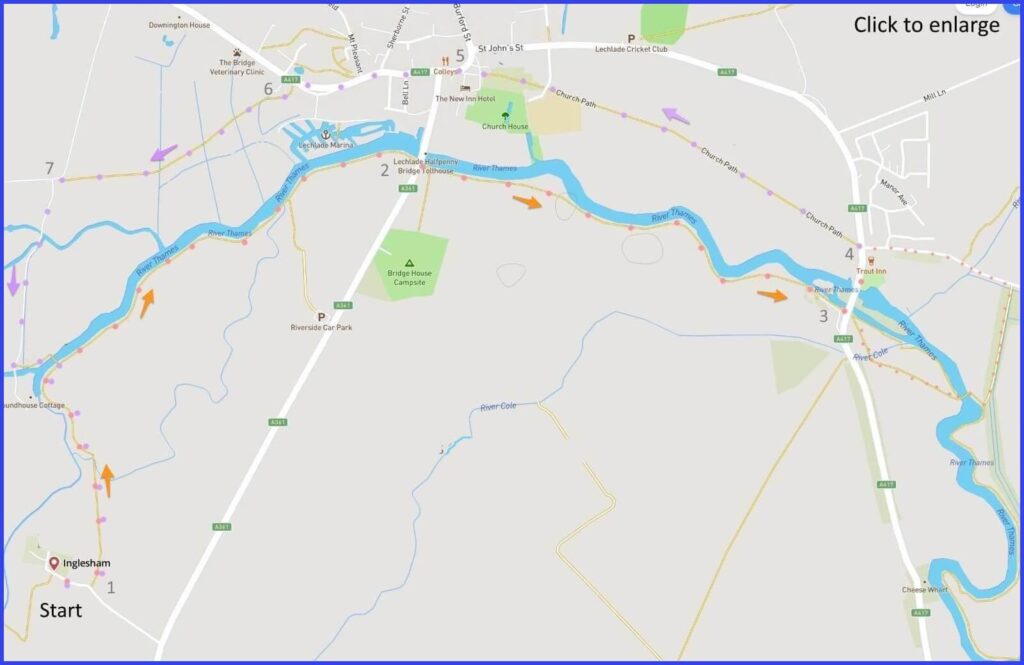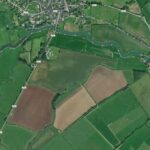A 5-mile walk around Inglesham starting at an extraordinary church, following the Thames pathway to a walk through the wool town of Lechlade. No slopes, no stiles. Click map to enlarge. Click here for arial view. Click here for PDF download. (There is a GPX route option here for phone/tablet download. But only follow this link after watching this GPX help video). Friendly warning: all files relating to walks are published here in good faith but on the understanding that users must be responsible for their own safety and wellbeing.
(Routes suggested from each map point + metres to next point)
There is some parking near the church.
1: Through kissing gate. Head 11 o’clock through one field to join riverside path [D]. 1.4km
2: Tunnel under the road to continue path. 1.1km
3: Turn left onto road (but no pavement for 100 yds. If concerned, take square root dotted small on map). 150m
4: Take ‘church path’ [F] on left after Inn. Follow to church [G]. 500m
5: Walk west down High Street. 500m
6: Take footpath on left side of road. Cross 3 streams. 500m
7: Pick up lane and immediately take its left direction route. Cross river [I]. Return to start. 1km
The pictures below are in the order things were seen on this walk. Clicking on any one will enlarge it (and the slideshow)
A circular route from a small village. The church is what makes this village well known – although the village’s modest population is now concentrated in the “Upper” place, a mile away. Though small in number, the locals do have community.
Much loved church
There is no sign of a congregation about this church [A]: but then since 1980 it has been termed a “redundant church” (although Anglican governance now prefers “closed church”). Given the delight it inspires in touring commentators, it could also be termed a “celebrity church”. Its special and much-admired personality comes from its protected – and so unchanged – status: so step inside and have an authentic encounter with the medieval churchgoing experience.
Well, perhaps. But some imagination does have to be exercised. The very age of the (seventeenth century) box pews [B] and wooden screens renders the sacred furniture a little .. well .. grubby. And the carefully preserved but higgeldy-piggeldy layers of wall painting contrasts with the smoothed surfaces we now expect in churches – typically restored to look as we like to suppose they once did. So this carefully protected and age-worn interior has to be taken as a rare, but precious, foundation – or skeleton – for imagination. Approached this way, it invites the visitor to launch an act of inventive re-construction. Only then can you really summon up something like the medieval experience.
We have William Morris to thank for this opportunity (he lived nearby at Kelmscott Manor with various highly-strung companions). Morris founded the Society for the Protection of Ancient Buildings, within which he had a particular mission to fund-raise and thereby protect Inglesham church from Victorian “redevelopment”. Which, thankfully, was successful. Don’t miss the 1000-year old wall sculpture inside. It depicts the virgin Mary holding Jesus in her lap. The infant (‘child’, surely) has his right hand extended (as if giving the benediction), while his left hand (most unusually) holds a book (what can it be?). Meanwhile another hand points down threateningly (or blessingly) from the heavens. This complex scene may be a little hard to decipher in the ancient carving – a schematised version here may help. Finally, if the church is closed then someone’s online tour of the church is here.
Much walked walk
Inglesham is at the junction of the Rivers Coln and Thames. But also at the start of the ‘Old Canal’ (Thames and Severn) – as it sets off west through the Cotswolds. On your walking way to the Thames-side path, note the Round House to your left (beside the giant willow [C]). It is one of five built in the 1790s for a ‘lengthsman’ – in this case a chap to manage the bridge and lock (and perhaps collect tolls). At that earlier time it looked more like this. Now it is a private house.
Wiltshire was not well served with navigable rivers. To further promote its role in trade and transport, a plan was hatched (1793) for the 28-mile Thames and Severn canal. This would run from Stroud to Inglesham at the head of the Thames. It included a 2-mile tunnel (with no tow path!) at Sapperton, the longest in the UK at that time. Sadly, the canal declined towards closure (1927), as Bristol-Midlands-London routes became better served by competing means of transport (including the railways). There is currently a plan to restore it.
As you walk along the Thames path (it goes to London), expect to see much messing about on the river [E]. But also notice [D] the pillbox (Type FW3/22). It was one point on the GHQ Red Stop Line – anticipating the 1940s German invasion. Before reaching the walk turn-around point you pass St Johns Lock (1790), the furthest upstream lock on the Thames. Notice the statue of Old Father Thames (1854): it once graced the grounds of the Crystal Palace.
Lechlade
The walk leads you into the town at the substantial church of St Lawrence, with its striking 8-sided spire. You enter the churchyard via ‘Shelley’s Walk’ [G] – honouring the fact that Percy Shelley (eminent atheist) was inspired to write a poem here, when visiting the town with his future wife:
The dead are sleeping in their sepulchres:
And, mouldering as they sleep, a thrilling sound,
Half sense half thought, among the darkness stirs,
Breathed from their wormy beds all living things around,
And, mingling with the still night and mute sky,
Its awful hush is felt inaudibly.
And so on. Immediately beyond the sleeping dead is the Market Place – the town’s centre with three main roads (and traffic nightmare) leading into it. There are signs of occupation in this town from neolithic times including, later, Romans. During subsequent prosperity it became more a trading than a manufacturing town – thanks to its water links and thus its capacity for conveying local cheese, corn, and quarried stone on its waterways. Consequently there are some wealthy eighteenth and nineteenth century houses on show. Pevsner says that those on the High Street are “a picturesque group, though none is outstanding” – he suggests slipping up Burford Street for the best.
The Wiltshire walk has taken you into South Gloucestershire (and back). Never mind. Lechlade is worth the visit: it’s a classic Cotswolds wool town. Not much about wool anymore of course – probably more about Marina life or commuting to Oxford, Birmingham and, who knows, even London.



![[A]](https://wiltshirewalks.com/wp-content/uploads/2022/08/inglesham01-150x150.jpg)
![[B]](https://wiltshirewalks.com/wp-content/uploads/2022/08/inglesham02-150x150.jpg)
![[C]](https://wiltshirewalks.com/wp-content/uploads/2022/08/inglesham03-150x150.jpg)
![[D]](https://wiltshirewalks.com/wp-content/uploads/2022/08/inglesham05-150x150.jpg)
![[E]](https://wiltshirewalks.com/wp-content/uploads/2022/08/inglesham04-150x150.jpg)
![[F]](https://wiltshirewalks.com/wp-content/uploads/2022/08/inglesham06-150x150.jpg)
![[G]](https://wiltshirewalks.com/wp-content/uploads/2022/08/inglesham07-150x150.jpg)
![[H]](https://wiltshirewalks.com/wp-content/uploads/2022/08/inglesham08-150x150.jpg)
![[I]](https://wiltshirewalks.com/wp-content/uploads/2022/08/inglesham09-150x150.jpg)